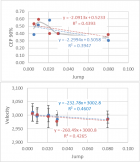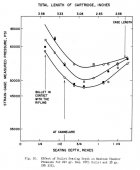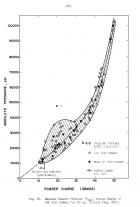222Jim
Silver $$ Contributor
I was going over some shooting results recently and noticed an (to me at least) interesting pattern. I am curious if any of you have seen similar trends and/or have any thoughts on why this trend appears to exist.
The "interesting pattern" is with respect to group precision versus jump. For reference, I'm shooting a .222 Remington, Berger 52 FBV, 19.40 gr of IMR4198, Lapua cases, and Federal GM205 primers. FYI, I judge precision in terms of CEP 90% which is roughly 1.75 times the Mean Radius (CEP 90 = Probability that 90% of shots will land within a given radius measured in MOA).
Looking at the chart below, what I'm seeing is the repeatability of my group precision results goes "wonky" as jump gets smaller. FYI:
(a) Each "dot" below is the average of an individual 20 shot group determined using the OnTarget TDS program.
- I shoot four 5-shot groups and then combine them using OnTarget TDS
(b) Standard Deviation of each jump measurement is +/- 0.0005".
(c) Results are based on 100 meter range.
In my opinion these results are good, i.e., a 0.50 CEP 90% is roughly equivalent to an average group diameter of 0.6" (mean radius 0.3"). But the trend has me scratching my head.
I have my own pet theory on why I'm seeing this trend. That theory is that at smaller jumps, the bullet lacks sufficient velocity as it enters the throat to smoothy overcome any load-to-load inconsistencies (i.e., bullet alignment/concentricity?). That results in a feedback loop in which bullets may slow/stall their forward motion for factions of a millisecond, thus creating different levels of back pressure needed to push the bullet forward. That then manifests itself as precision inconsistencies.
And, for reference, I've also included the velocity measurements (velocity error bars equal 2 times the Standard Deviation).
Anybody have any thoughts on this?

The "interesting pattern" is with respect to group precision versus jump. For reference, I'm shooting a .222 Remington, Berger 52 FBV, 19.40 gr of IMR4198, Lapua cases, and Federal GM205 primers. FYI, I judge precision in terms of CEP 90% which is roughly 1.75 times the Mean Radius (CEP 90 = Probability that 90% of shots will land within a given radius measured in MOA).
Looking at the chart below, what I'm seeing is the repeatability of my group precision results goes "wonky" as jump gets smaller. FYI:
(a) Each "dot" below is the average of an individual 20 shot group determined using the OnTarget TDS program.
- I shoot four 5-shot groups and then combine them using OnTarget TDS
(b) Standard Deviation of each jump measurement is +/- 0.0005".
(c) Results are based on 100 meter range.
In my opinion these results are good, i.e., a 0.50 CEP 90% is roughly equivalent to an average group diameter of 0.6" (mean radius 0.3"). But the trend has me scratching my head.
I have my own pet theory on why I'm seeing this trend. That theory is that at smaller jumps, the bullet lacks sufficient velocity as it enters the throat to smoothy overcome any load-to-load inconsistencies (i.e., bullet alignment/concentricity?). That results in a feedback loop in which bullets may slow/stall their forward motion for factions of a millisecond, thus creating different levels of back pressure needed to push the bullet forward. That then manifests itself as precision inconsistencies.
And, for reference, I've also included the velocity measurements (velocity error bars equal 2 times the Standard Deviation).
Anybody have any thoughts on this?













